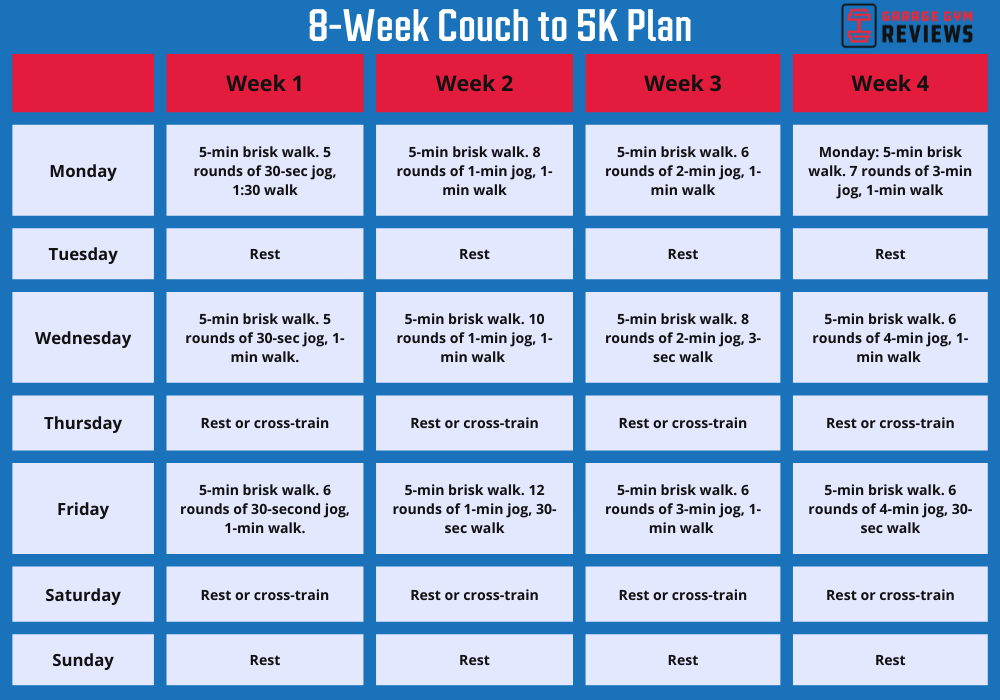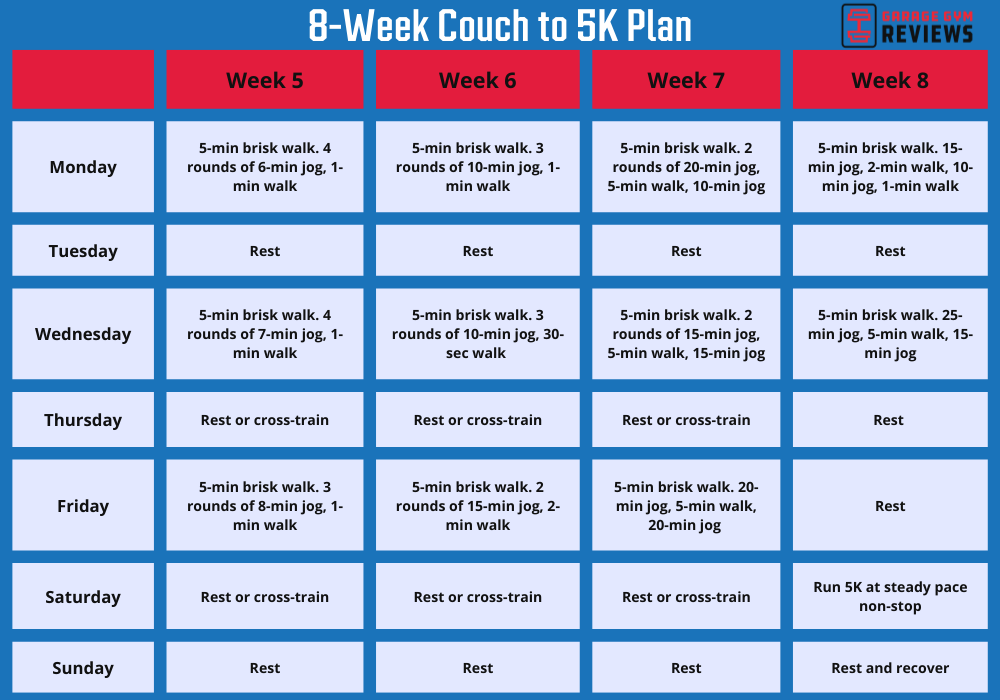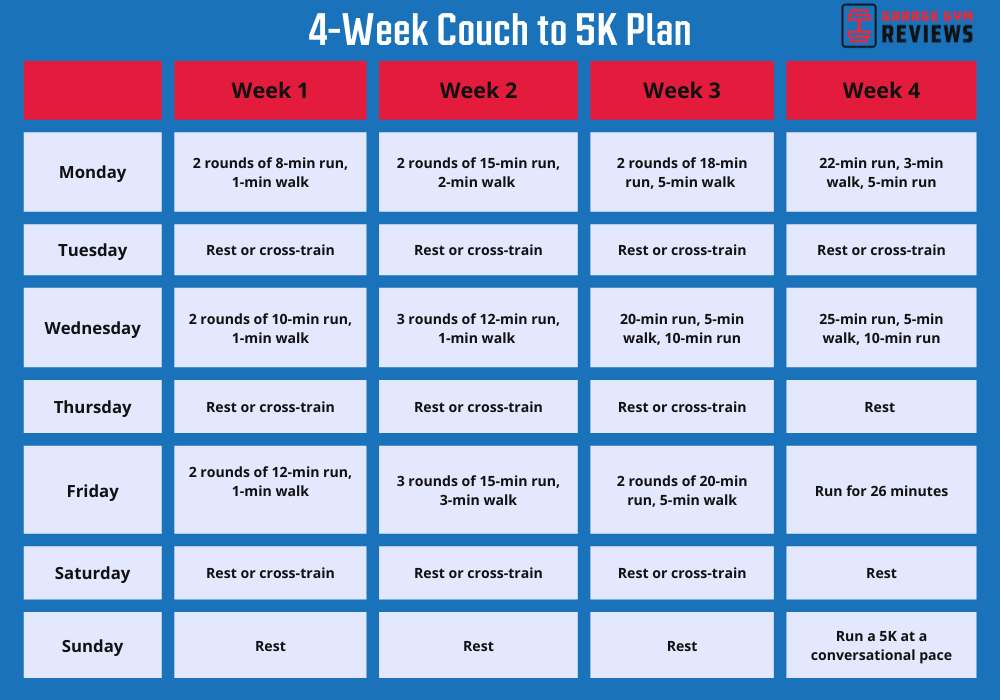We test and review fitness products based on an independent, multi-point methodology. If you use our links to purchase something, we may earn a commission. Read our disclosures.
You’ve never run before, or maybe it’s been a while since you laced up your running shoes. If you set a goal to run a 5K race and want to be ready for that start line, we can help.
There’s a running program that simplifies the training process. It’s famously known as the “Couch to 5K plan,” or C25K plan, and it mixes running with walking breaks, allowing you to recover and adapt to the load.
Below, we have a comprehensive couch to 5K planning guide that can be tailored to your needs and fitness level.
What is Couch to 5K Planning?
A man named Josh Clark developed the first Couch to 5K program in the mid-90s with the intention of motivating his mother to start running. The first plan was nine weeks, though now there are many variations. This training program has inspired millions of beginner runners, and it’s even recommended by the National Health Service (NHS) in the United Kingdom.
Whatever the setup, this is a running plan for beginners who have never run, those who have led a sedentary lifestyle, or people who have taken a long break from running. The goal of a Couch to 5K plan is to gently introduce people to covering longer distances without experiencing burnout or overtraining.
At its core, Couch to 5K is a kind of interval training that involves a mix of walking and running with rest periods in between if necessary. It involves three days of running in a week with varying duration.
The best part of the Couch to 5K plan is that it’s time-based, not distance-based. You’ll run for a certain amount of time, and walk for a certain amount of time. The running part of the Couch to 5K plan is simply jogging slowly. Power walking or speed walking is recommended instead of running for those susceptible to injuries or who aren’t yet ready to run.
As the plan progresses, the amount of time spent running increases and walking time decreases until you can do the entire 5K run without stopping.
Benefits of the Couch to 5K Plan
The primary benefit of the Couch to 5K plan is that anyone can follow it. It does precisely what the name suggests: It gets a newbie runner off the couch to run a 5-kilometer distance. A Couch to 5K plan is an approachable and progressive way of building up to getting used to the strains of running. It breaks down the training sessions into manageable chunks and helps build a fitness base.
The Couch to 5K plan lays the groundwork for a healthy lifestyle. It also helps develop a good cardiovascular base and muscular endurance.
The plan is simple to follow and seeks to minimize the risk of injuries by gradually ramping up the workload. Other latent benefits are potential improvements in mental health and self-confidence as you progress into your training plan.
How Long Does the Couch to 5K Plan Take?
The original Couch to 5K plan was designed for nine weeks, but it now has many variations. You can choose a plan based on your current activity level, lifestyle, and fitness history. However, most Couch to 5K plans are between eight to 10 weeks. These are generally for people who are inactive and do not have any base-level fitness. People who are active but are not runners may be able to ramp up to a 5K distance with a four- to six-week plan.
Will You Lose Weight on the Couch to 5K Plan?
Losing weight on a Couch to 5K plan depends upon several factors as well as your general lifestyle while following the plan. It’s a process of calories in versus calories out. Running can burn a significant amount of calories, which can lead to weight loss. If you want to lose weight on the Couch to 5K plan, then eating a healthy, balanced diet will be essential.
3 Steps to Take Before You Start Your Couch to 5K Plan
Once you’ve selected the right Couch to 5K plan that suits your requirements and current fitness level, it’s time to focus on a few other things before you start implementing the plan. Let’s go through them here:
Buy Proper Running Shoes
Consider spending a little extra on a good pair of running shoes. No, sneakers will not do. We recommend going to a running shoe store to have experts analyze your gait and match you to the right kind of shoe. In general, running distances usually demand a shoe with ample cushioning to protect your ankles and knees from the impact of running.
Have the Right Gear
Running-specific apparel may make your running experience more enjoyable. Invest in a moisture-wicking lightweight T-shirt and shorts with anti-chafing fabric. The material of the cloth should be soft, breathable, and stretchable. If you suffer from chafing on your thighs, consider buying leggings. It is also a good idea to carry a small lightweight water bottle while running/walking.
Schedule Your Runs
Scheduling your runs ahead of time eliminates excuses to get out the door. Figure out ahead of time when you can squeeze in a run on a lunch break, before work, or on the weekends. Once you schedule it, stick to it.
Running Pace Calculator
Try this running pace calculator to understand your mileage pacing throughout your training plan.

Calculate Your Running Pace
Enter your stats in any 2 of the fields below to calculate the third.
8-Week Couch to 5K Training Schedule
The below eight-week Couch to 5K training plan is designed specifically for new runners or those who might refer to themselves as “couch potatoes.” Following the plan diligently may help you reach the finish line on 5K race day.
Do a proper five to 10-minute warmup before and cooldown after each run to promote recovery. Try to keep your heart rate low and maintain a conversational pace. Consult a physical therapist or your doctor in case of any injuries.

Week #1
Monday: 5-minute brisk walk. 5 rounds of 30-second jog, 1:30 walk
Tuesday: Rest
Wednesday: 5-minute brisk walk. 5 rounds of 30-second jog, 1-minute walk
Thursday: Rest or cross-train
Friday: 5-minute brisk walk. 6 rounds of 30-second jog, 1-minute walk
Saturday: Rest or cross-train
Sunday: Rest
Week #2
Monday: 5-minute brisk walk. 8 rounds of 1-minute jog, 1-minute walk
Tuesday: Rest
Wednesday: 5-minute brisk walk. 10 rounds of 1-minute jog, 1-minute walk
Thursday: Rest or cross-train
Friday: 5-minute brisk walk. 12 rounds of 1-minute jog, 30-second walk
Saturday: Rest or cross-train
Sunday: Rest
Week #3
Monday: 5-minute brisk walk. 6 rounds of 2-minute jog, 1-minute walk
Tuesday: Rest
Wednesday: 5-minute brisk walk. 8 rounds of 2-minute jog, 3-second walk
Thursday: Rest or cross-train
Friday: 5-minute brisk walk. 6 rounds of 3-minute jog, 1-minute walk
Saturday: Rest or cross-train
Sunday: Rest
Week #4
Monday: 5-minute brisk walk. 7 rounds of 3-minute jog, 1-minute walk
Tuesday: Rest
Wednesday: 5-minute brisk walk. 6 rounds of 4-minute jog, 1-minute walk
Thursday: Rest or cross-train
Friday: 5-minute brisk walk. 6 rounds of 4-minute jog, 30-second walk
Saturday: Rest or cross-train
Sunday: Rest

Week #5
Monday: 5-minute brisk walk. 4 rounds of 6-minute jog, 1-minute walk
Tuesday: Rest
Wednesday: 5-minute brisk walk. 4 rounds of 7-minute jog, 1-minute walk
Thursday: Rest or cross-train
Friday: 5-minute brisk walk. 3 rounds of 8-minute jog, 1-minute walk
Saturday: Rest or cross-train
Sunday: Rest
Week #6
Monday: 5-minute brisk walk. 3 rounds of 10-minute jog, 1-minute walk
Tuesday: Rest
Wednesday: 5-minute brisk walk. 3 rounds of 10-minute jog, 30-second walk
Thursday: Rest or cross-train
Friday: 5-minute brisk walk. 2 rounds of 15-minute jog, 2-minute walk
Saturday: Rest or cross-train
Sunday: Rest
Week #7
Monday: 5-minute brisk walk. 2 rounds of 20-minute jog, 5-minute walk, 10-min jog
Tuesday: Rest
Wednesday: 5-minute brisk walk. 2 rounds of 15-minute jog, 5-minute walk, 15-minute jog
Thursday: Rest or cross-train
Friday: 5-minute brisk walk. 20-minute jog, 5-minute walk, 20-minute jog
Saturday: Rest or cross-train
Sunday: Rest
Week #8
Monday: 5-minute brisk walk. 15-minute jog, 2-minute walk, 10-minute jog, 1-minute walk, 15-minute jog
Tuesday: Rest
Wednesday: 5-minute brisk walk. 25-minute jog, 5-minute walk, 15-minute jog
Thursday: Rest
Friday: Rest
Saturday: Run 5K at an unhurried pace non-stop. It should take around 30 to 40 minutes
Sunday: Rest and recover
Four-Week Couch to 5K Plan
The below four-week Couch to 5K plan is for active people who are non-runners. Warmup and cooldown before and after each run.

Week #1
Monday: 2 rounds of 8-minute run, 1-minute walk
Tuesday: Rest or cross-train
Wednesday: 2 rounds of 10-minute run, 1-minute walk
Thursday: Rest or cross-train
Friday: 2 rounds of 12-minute run, 1-minute walk
Saturday: Rest or cross-train
Sunday: Rest
Week #2
Monday: 2 rounds of 15-minute run, 2-minute walk
Tuesday: Rest or cross-train
Wednesday: 3 rounds of 12-minute run, 1-minute walk
Thursday: Rest or cross-train
Friday: 3 rounds of 15-minute run, 3-minute walk
Saturday: Rest or cross-train
Sunday: Rest
Week #3
Monday: 2 rounds of 18-minute run, 5-minute walk
Tuesday: Rest or cross-train
Wednesday: 20-minute run, 5-minute walk, 10-minute run
Thursday: Rest or cross-train
Friday: 2 rounds of 20-minute run, 5-minute walk
Saturday: Rest or cross-train
Sunday: Rest
Week #4
Monday: 22-minute run, 3-minute walk, 5-minute run
Tuesday: Rest or cross-train
Wednesday: 25-minute run, 5-minute walk, 10-minute run
Thursday: Rest
Friday: Run for 26 minutes
Saturday: Rest
Sunday: Run the 5K distance at a conversational pace
Complements to Your Couch to 5K Training Plan
Running is a fantastic workout, but if you want to get the most out of your running sessions, consider a few other essential factors that will complement your couch to 5K training plan.
Strength Training
Adding strength training or cross-training to your plan two to three times a week helps in several ways. For example, cycling will help you take a break from the high-impact sport of running while working on your cardiovascular system. You can do bodyweight or weighted strength training workouts to strengthen your glutes, core, leg muscles, and upper body. Planks, push-ups, squats, glute bridges, lunges, and single-leg balance are great running-specific strength exercises.
Hydration and Nutrition
Make sure you eat a healthy diet, and make a habit of replenishing electrolytes after your run. A proper diet plan aids in muscle recovery and boosts the adaptation process.
Stretching/Recovery
Stretching and yoga may speed up the recovery process by improving blood flow and releasing the tightness in the muscles. Do dynamic stretches before your workout to help fire up your muscles. Static stretches after your running may improve flexibility and mobility, which helps in your running performance.
Final Thoughts on Couch to 5K Planning
Following a Couch to 5K plan will bring many positive changes in your life if you have never followed any structured training plan. Pick the best plan that suits your current fitness level, or you may hire a running coach to help you develop your Couch to 5K program. It may feel challenging at the beginning but do not give up. Strive through the initial days until going out on training runs becomes a habit.
- Select the appropriate Couch to 5K plan depending upon your current fitness level. Consider using an app, like Couch to 5K, to take some of the guesswork out of the equation.
- Even if you need to rest for a week, do so whenever necessary. Listen to your body.
- Complement your plan with proper nutrition, hydration, and strength training.
- Invest in the right running clothes and comfortable shoes to make running more enjoyable.
Couch to 5K Planning FAQs
How do I prepare for a Couch to 5K?
Select the plan that suits your current fitness level and follow it consistently for the entire period. Do a proper warmup and cool down five to 10 minutes before and after the workout. Eat healthy food that helps in recovery and avoid any junk food. Hydrate yourself with an electrolytes mix. Get enough sleep and stretch nicely before another training session.
Can I do a Couch to 5K in four weeks?
It depends on how fit you are right now. Rushing through the plan could result in injury. Some Couch to 5K plans can help you complete the distance in four weeks, but they are best suitable if you are a non-runner but still keep active in your day-to-day life. It is appropriate to select an eight-week plan (or longer) if you are completely inactive.
Is Couch to 5K good for weight loss?
It would be best if you complement it with a good diet. It may result in some weight loss, but the plan aims to make you a healthy individual who can run the 5K distance without stopping. It may kickstart your fitness journey, which could eventually help you lose weight sustainably.
What is a good 5K time for beginners?
On average, many people take about 25 to 35 minutes to finish the 5-kilometer distance. A good beginning goal would be 30 minutes, which is a 10-minute-per-mile pace.
Further reading

Lateral raises are one of the best isolation exercises to include in your shoulder workout. Check out our guide for trainer tips, variations, and more! Read more

Check out the 10 best lat pulldown alternatives picked by a strength coach to enhance your back workout and maximize your muscle strength and size. Read more

You’ve never run before, or maybe it’s been a while since you laced up your running shoes. If you set a goal to run a 5K race and want to be ready for that start line, we can help.There’s a running program that simplifies the training process. It’s famously known as the “Couch to 5K plan,” or C25K plan, and it mixes running with walking breaks, allowing you to recover and adapt to the load. » Read more about: A Complete Couch to 5K Planning Guide For a Successful Run » Read more

Brian Shaw is a 4-time World's Strongest Man and out of all the gyms that Brian could train at, where does he train most? His garage gym. Here it is in all its glory! Read more

